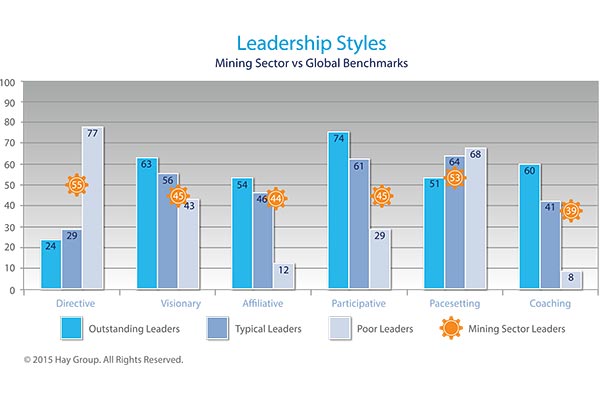Why would a highly regarded sector with well-paying jobs struggle with issues of turnover and employee engagement? Clearly money alone doesn’t buy you happiness. Let’s also consider how the leadership styles commonly used in the mining sector can help or hinder performance.
We’ve all heard the phrase, “the leader sets the tone,” but would you have guessed the leader sets 70% of the tone? Joint research from Hay Group and Harvard University confirms the leadership styles deployed by leaders account for up to 70% of the variance in employee engagement. Furthermore, the level of employee engagement in an area accounts for up to 30% of the variance in operational and financial results. Clearly the leader does set the tone — and impacts the results!
Let’s first understand what is meant by leadership style, then secondly explore the patterns of leadership styles most commonly found in the mining sector and the implications for the mining sector, as it relates to attracting and retaining the talent needed to drive future projected growth.
Six leadership styles
What makes for great leadership? Providing task clarity? Casting vision? Building relationships? Drawing on team input? Working alongside people? Providing feedback? The truth is “all of the above” — when used at the right time, in the right place and in moderation.
The six leadership styles are: directive (“Do what I tell you.”); visionary (“Here’s where we’re going and why.”); affiliative (leadership through relationship); participative (“Let’s decide together.”); pacesetting (“Run fast and keep up!”); and coaching (long-term development of others).
Top-performing leaders have been shown to have skill using four or more of the six styles, but only 20% of leaders achieve this level. The research also shows most leaders are over-reliant on only one style, which limits their effectiveness as a leader.
To build a culture of high performance, every leader should develop skills across the full toolbox of styles. In the same way a golfer uses a range of clubs for different situations, leaders need to develop comfort and skill using a range of leadership styles. The more styles you have command over, the more situations you can manage effectively.
The attached table compares the mining sector to a cross-sector group and shows that the two most commonly used styles in mining are directive and pacesetting. Unfortunately, over-reliance on these two leadership styles is strongly correlated to low levels of employee engagement and high levels of turnover. Not surprisingly, the approaches of “Do what I tell you” and/or micro-managing the work (“run fast, keep up”) don’t exactly instill high levels of motivation in people.
Naturally, it’s human nature for a leader (or even a sector) to perhaps rationalize high levels of directive and pacesetting leadership styles by saying: “We’re heavily regulated,” “We’re process-driven, and there’s only one way to do it” or “Why waste time if I know how it should be done, and I can just tell people?” But these excuses just don’t hold water.
From boardroom to mine site, the evidence suggests many leaders in the mining sector would benefit by being more visionary (explain what and why), more participative (asking vs telling), and doing more coaching (feedback).
Leaders can better understand their mix of the six leadership styles via a formal feedback tool completed by both direct reports and self. This feedback provides the basis for self-awareness, coaching, development planning and growth as a leader to master the full toolbox of styles.
What’s your mix of leadership styles? How would your direct reports see it?
To summarize, high-performing leaders master four or more leadership styles and learn to use the right tool for the job. They also have higher levels of retention, engagement and results to show for their efforts.
Remember, local leadership is high among the primary reasons people stay in jobs, and ironically is also high among the primary reasons people leave jobs, consistently ranking higher than pay in every study.
Particularly in mining, attracting and retaining the talent needed to execute strategies will be critical. Some mining companies will be able to do this better than others, so make no mistake: building world-class leaders is an essential part of building a world-class mining operation. Are the styles of your leaders helping or hindering your operation?
— Based in Regina, Sask., Brent Pederson is Hay Group’s Practice Leader, Leadership & Talent, Western Canada, and sits on Hay Group’s Global Council on Performance Management. He does extensive work in the mining sector in the areas of leadership development, employee engagement, performance management, coaching and succession planning. Brent can be reached at (306) 359-0181, or brent.pederson@haygroup.com.
Hay Group is a global management consulting firm with 86 offices in 49 countries and is ranked No. 1 globally in leadership development. Visit www.haygroup.com for more information.






Be the first to comment on "Commentary: Are leadership styles in mining helping or hindering?"